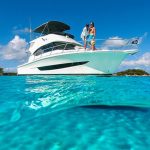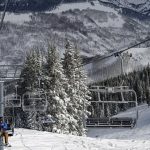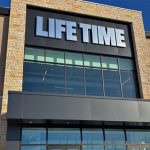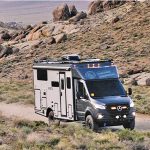Overall sales for both specialty and chain stores were up 4% in dollars to $729.9 million for the August through November period of 2006, compared to $698.6 million reported last year, according to the SIA Retail Audit. Unit sales were up 1%. New for this season, the SIA Retail Audit now tracks the Internet channel of distribution. For the August through November period of 2006, SnowSports Internet sales totaled a significant $126.0 million. Total sales at specialty stores, chain stores and via the Internet climbed to $856.0 million for the August through November period.
“Sales for the Western half of the US remained vibrant and
helped keep overall numbers ahead of the same August to November period last season. Even with the warm weather out East, overall specialty apparel sales surged 18% in dollars as insulated alpine tops continued to fly off the shelves,” said Christine Martinez, market research manager for SnowSports Industries America (SIA).
Sales at specialty ski and snowboard shops were up 5% in dollars compared to last season. In
dollars, that translates to $568.3 million in sales compared to $539.7 million in 2005. Unit sales
were up from last season 4%. The SIA Retail Audit, conducted by Leisure Trends Group, tracks
and reports sales in all snow sports product categories. This is the second report of six that look
at sales through March 31, 2007, the end of the winter season.
Off to a significantly strong start this season, specialty apparel sales (including tops, bottoms,
suits and snowboard) are ahead 18% in dollars as compared to the same August through
November period last year. By the end of November 2006, apparel sales had reached $208.9
million as compared to equipment sales which totaled $214.6 million, just $5.7 million more.
Last season at this time, equipment outsold apparel by $44 million.
Insulated parka sales rose 24% in dollars with sales reaching $60.8 million by the end of
November 2006. Womens insulated parkas led the category with $28.2 million in sales while
outselling mens insulated parkas 127,000 to 84,000 units. In the insulated parka category, 60%
of the adult units sold are womens.
Softshell parka sales continue to thrive in specialty stores. Overall dollar sales jumped 36%
when comparing this period to the same period a year ago. From August through November
2006, softshell parkas earned $10.6 million in sales. In dollars, mens gained 38%, womens
30% and juniors 69%. In softshells, 63% of the adult units sold are mens.
Shell parkas declined a slight 1% in dollars, reaching $17.4 million for the August through
November period. Mens shell parka dollars, 62% of all shell dollars sold, increased 4% while
womens shell parkas fell 7% in dollars.
Vests (no fleece) and fleece (includes vests) continue to generate the increase in sales which
began three seasons ago. Dollar sales were up for both categories, 17% and 47%,
respectively, over last season. Fleece managed to bring in a total of $38.3 million in sales
through November 2006. Sweaters bounced back after a slow season last year with a 9%
dollar gain and $5.6 million in sales thus far this season.
Alpine apparel bottoms increased 7% in dollars over the same period last year with junior
bottoms contributing an impressive dollar gain of 16%. Stretch waist pant dollars surged 18%.
Apparel suits continue to decline, dipping 10% in dollars.
Junior alpine apparel sales look promising with dollar increases in insulated parkas (up 18%),
softshell parkas (up 69%) and bottoms (up 16%).
Snowboard apparel sales jumped up 12% in dollars reaching $33.2 million in sales by the end of
November 2006. Snowboard tops and snowboard bottoms are showing promise this period
over last, up 20% and 11%, respectively. Womens snowboard tops and bottoms saw
significant dollar increases over last season for the same period, 40% and 25%, respectively.
Womens snowboard tops grew from 28% of all top dollars sold to 33%. Junior snowboard top
and snowboard bottom dollars increased 15% and 3% over last season, respectively.
So far this season, snowboard tops outsold snowboard bottoms by a ratio of just 1.3 to 1.
Compare that to alpine tops which outsold alpine bottoms 4 to 1 in the same period.
The accessories category in specialty stores also grew from this period over last, up 3% in
dollars and reaching $144.8 million by the end of November 2006. The apparel accessories
category increased sales 8% over the same period last year, reaching a total of $80.4 million by
the end of November 2006. Turtlenecks (up 20%), winter boots (up 19%), neck gaiters (up 9%),
base layer (up 7%), headwear (up 7%), socks (up 7%) and gloves (up 3%) each contributed to
this dollar increase.
Equipment accessory sales declined 3% although dollar gains came from auto racks (up 12%),
helmets (up 4%) and luggage (up 2%). Snow decks/skates (down 60%), sunglasses (down
23%) and snowshoes (down 30%) saw considerable drops in dollar sales.
From August through November 2006, snowboard equipment sales (including snowboards,
boots and bindings) were down 10% in dollars with sales reaching a total of $68.5 million.
Snowboards (down 8% totaling $34.4 million in sales), boots (down 13% totaling $17.8 million)
and bindings (down 12% totaling $16.2 million) all experienced dollar decreases this season
over last.
All mountain boards jumped 35% in dollar sales reaching $4.6 million in sales by the end of
November 2006. All mountain boards accounted for 14% of all board dollars sold through
November (up from 10%). Freestyle boards, accounting for 43% of all boards sold so far this
season, fell 11% in dollars while freeride boards dropped 20% in dollars.
Carryover snowboard sales jumped 42% in dollars and increased their share of the market from
7% of the units to 11%.
Overall equipment sales (alpine, snowboard, Nordic, Telemark and Randonee/AT) were down
3% in dollars as compared to last season with sales totaling $214.6 million from August through
November 2006. In specialty stores, alpine equipment (including skis, ski systems, boots,
bindings and poles) grew 2% in dollars this season over last.
Integrated ski system sales continue to escalate totaling $38.7 million through the end of
November, an increase of 20% in dollars when comparing this August to November period to
the same period a year ago. Nearly 89,000 pairs were sold this period at retail. Add integrated
systems to alpine skis and total alpine ski sales grew 6% in dollars and totaled $71.4 million
from August – November 2006.
Adult midfat systems, 49% of all system dollars sold (up from 43%) surged 35% in dollars.
While still a small category, fat and super fat systems floated up 132% in dollars. Junior ski
systems surged 95% in dollars. Bindingless junior skis still outsold systems more than 3 to 1.
Alpine skis, excluding integrated systems, fell 7% in dollars over last season, ending November
2006 with $32.7 million in sales. In three successive October and November periods, the ratio
of alpine ski units sold to systems has fallen from 2.75 to 1, to 1.89 to 1, to just 1.31 to 1 this
season-to-date.
Adult twintip skis gained 15% in dollars, reaching $5.0 million in sales for the period of August
November 2006. Twintips now account for 15% of all alpine ski dollars. The adult twintip ski
category now includes all twintip skis, not just freestyle twintip skis as was previously tracked.
Through November, carryover ski sales jumped 40% in dollars as retailers attempted to unload
excess stock. Season-to-date, carryover skis accounted for 14% of all ski units sold, up from
11% a season ago.
From August through November 2006, total alpine boot sales remained even in dollars ($52.8
million in sales). Through November, approximately 20,000 more pairs of boots were sold than
skis.
Dollars increased for adult high performance boots (up 7%) but fell for adult sport performance
boots (down 13%), adult soft boots (down 80%), adult recreation boots (down 6%), and junior
boots (down 8%). So far, 50,000 junior boots have been sold compared to 47,000 junior skis
and systems.
Stand-alone binding sales dropped a hefty 17% in dollars, totaling $9.5 million at the end of
November.
Adult DIN 8-11 bindings fell 19% in dollars. Higher-end performance adult DIN 12-14 bindings
fell 18% in dollars. Junior binding sales plunged 24% in dollars.
The alpine pole category is up 6% in dollars over last season thanks to a 34% unit jump in junior
poles and a 31% unit jump in carryover sales.
Nordic ski equipment sales decreased 13% in dollars this season over last. Nordic skis fell 16%
in dollars while Nordic boot dollars decreased 13%. Telemark ski equipment sales fell 4% in
dollars. While still a tiny category, randonee/AT equipment sales are off to a strong start with
dollars up 14% over last season.












